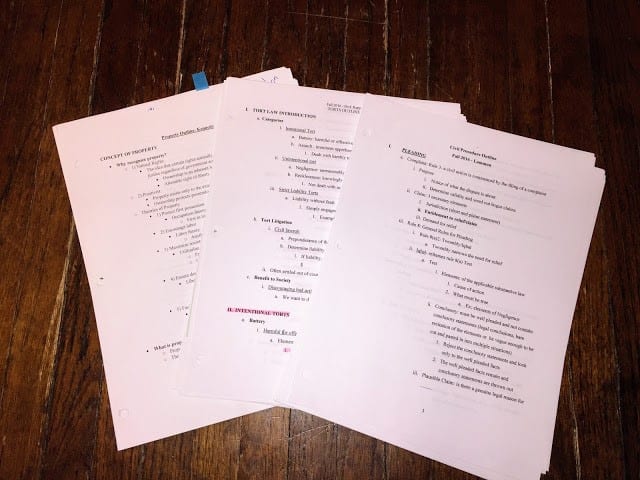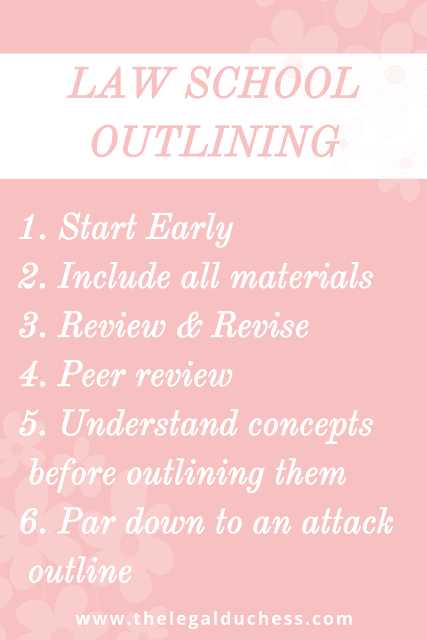Guest Blogger: Brandy Brown, The Legal Duchess
Brandy Brown is a second-year law student at the University of Toledo College of Law, where she attends on a full tuition scholarship. Prior to law school, she earned dual bachelor’s degrees in legal studies and history. She is currently interning at her local criminal prosecutor’s office and plans to pursue a career in criminal law after graduating and passing the bar. Before starting law school, Brandy launched The Legal Duchess — a blog to document her law school experience… Read More
I had NO idea what on earth an outline was when I started law school. I looked all over the internet, talked to all my professors, talked to 2Ls and 3Ls and yet I still did not fully understand what I was supposed to be doing. I gave it the good old college try over my 1L Thanksgiving break because prior to that, I just hadn’t been able to wrap my head around what I needed to do and kept putting it off. Come exam time, I studied the crap out of those outlines but I was not 100% confident I had everything I needed to know or had it arranged and synthesized correctly.
Throughout my first semester of law school, just the word “outline” caused me to have extreme anxiety. Now that I have finished semester two, I am feeling much better about the whole process. So for anyone out there who is struggling the way I did first semester, I truly hope this helps! A good outline is a big key to law school exam success so understanding the process is important.
What is an Outline?
Ah, the magic question. A law school outline is a full summary/description of the semester’s class concepts and black letter law. I use my class textbook’s Table of Contents as a framework and fill in with everything we learned: the rules, the concepts, hypotheticals and sometimes the cases (many professors do not require/want you to memorize cases but I find it helpful to plug them into my outline to spark my memory on how that rule applies in real life; and some professors will require you to know the case names). It is a constant process to stay updated throughout the semester (more on that later).
As the semester progresses, you adjust the information, layer the concepts and eventually start to remove unnecessary info, concepts you have locked down, and par the outline down to the things you need to memorize for the exam. It is an ever-evolving process throughout the semester until you get down to the attack outline for exam time. Outlines give you a class-specific study tool. Come exam time, you have your outline down to the absolute necessities and you have to have that sucker memorized. This is called your attack outline. Some people put this on flashcards and some just memorize it whole. I did a little bit of both.

Why Outline?
Outlining is a framework of the laws and principles you learn throughout the semester. By outlining, you are forced to synthesize the information, see how everything fits together, and form your own process for understanding and applying the rule. It is a study process just as much as it is a study tool. By outlining, you reaffirm the information in your memory, find places that require clarification and identify the big, recurring rules and how the rules interact together. Thinking long-term, outlines are also the tool you can save and use for future use when studying for the bar exam. A good outline can make bar prep so much easier.
From personal experience, outlining saved my Contracts I grade. Throughout the semester, I was utterly and completely confused. It just seemed like lots of abstract rules that did not fit together as a whole. When I sat down at the end of the semester and outlined everything, I had a complete light-bulb moment — everything fit together when I was forced to fit it into the larger outline. I ended up with a pretty decent grade in Contracts thanks to my outlining process.

1. Start Early
This was my downfall first semester. I left 90% of my outlining for Thanksgiving break, due mostly to the fact that I did not fully understand how to outline. Thus, I spent my whole break bent over my computer. I spent the week before finals trying to make sure my outlines were complete and correct/getting clarification from teachers, and that left my actual memorization/deep study for exam week. Not the best system for success.
Second semester, I started the outlining process much sooner. I had all my outlines done during the last week of classes, used reading week to clarify and compare with classmates and got to deep studying much sooner. I did not feel nearly as rushed and stressed as I did first semester. The sooner the better when outlining. Second semester, I was able to bring my GPA up 2 full points and I think my smarter approach to outlining was a big contributor to that improvement.
I think it is much easier to do a little at a time so I worked weekly on my outlines and kept them updated. I had no classes on Friday’s so I used this day for relaxing, reviewing and outlining. This also helped to reaffirm the information consistently and continually. Outlining helps you to synthesize the information and rules — so by outlining weekly, you are making that an active and continuous process. This way, at the end of the semester, you are just memorizing and not still trying to synthesize and understand the concepts. It also keeps you from having to spend a few days doing nothing but outlines, because that is exhausting and not nearly as good for retention and synthesization.
2. Incorporate ALL Materials
Outlines need to be made utilizing all class materials because anything is fair game on the exam. I use my book, my reading notes, class notes, class PowerPoints and any recommended supplements. This way, no matter what pops up on the exam, you have it covered and studied. You never want to get trapped up in just outlining from your notes because professors often pull from the book for multiple-choice questions.
One material to utilize but be careful of is commercial outlines or outlines from upperclassmen. While helpful for some things, you never want to rely solely on these. You need to mostly draw from your class materials. Only use outside outlines as supplements, guidelines or help for a tricky topic you are struggling to understand. Doing your own work is integral.
3. Understand It Before You Outline It
Outlining is great but if you are just copy and pasting or re-typing words off a page, that will not help you learn. If you do not have an understanding of the concepts and law before you start the outlining process, it will not be nearly as effective. You will end up studying an outline that has spots that you still do not understand. The studying stage is not when you should be trying to understand the material, that needs to happen much earlier. When I come to a spot in my notes that I am confused by, I highlight it in my outline, skip over it and make an appointment to go see the professor and work out the issue. This way, I know everything in that outline is something I have worked through and gained understanding of. That just leaves memorization and studying come exams. Much less stressful!
4. Constant Review and Revision
Throughout the semester, concepts build upon each other. It may happen that you outline something and a few weeks later, something builds upon it and adjusts the concept. Consistently going back through the outline and reviewing will help with this situation. You revise as the concepts evolve and it leaves you with a very complete and synthesized outline at the end of the process.
5. Go Over with Peers
Once you have completed your outlines and are satisfied, make a point to review them with peers or your study group. This helps to ensure that you got all the information and that you do not have anything confused. Last semester, I must have typed a piece of my outline while sleepy and had two rules mixed up. It was not until I went over my outlines with my study group that this mess-up was caught. Had I not reviewed with a group, I would have studied the wrong rules thanks to a simple, exhaustion-induced mistake. It never hurts to go over things with a group of trusted peers from the same class. Also, sometimes someone will have a slightly better rule statement or understanding of something that can help bolster your knowledge and exam performance.
6. Make Your Own!
There are outlines all over the internet. They hand you books of them at orientation and many upperclassmen will willingly hand you their old 1L outlines. It may be appealing to just use one of these outlines and save the time of making your own, but you do yourself a huge disservice. By doing that, you miss out on the added learning and understanding gained from the outlining process. Also, what if that outline doesn’t cover everything your class covered, or has things you didn’t? That means you either study things you do not have to or fail to study things you should. It is best to make your own and rely on your own work. Making your own outlines is long and tedious but so necessary and will really help you in the long run.
Outlining is not very fun but it is integral to law school success. Just suck it up and type them out. It is totally worth it.



